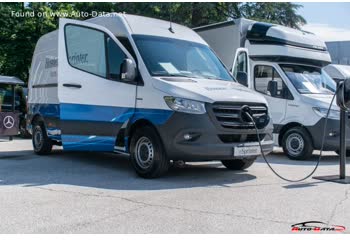Everything you need to know about specifications and performance - Mercedes-Benz Sprinter 2018 - 211 CDI (114 Hp) W910 9G-TRONIC

Overview:
What is the engine capacity of a Mercedes-Benz Sprinter 2018?
The engine capacity of the Mercedes-Benz Sprinter 2018 is 2143.
Mercedes-Benz Sprinter 2018 How many horsepower?
The engine power of the Mercedes-Benz Sprinter 2018 is 114 Hp @ 3800 rpm..
What is the Mercedes-Benz Sprinter 2018 engine?
Mercedes-Benz Sprinter 2018 engine is OM 651.955. (Click to see other cars using the same engine)
How much gasoline does a Mercedes-Benz Sprinter 2018 consume?
The Mercedes-Benz Sprinter 2018 consumes 7.8-8.3 liters of gasoline per 100 km
General:
Brand: Mercedes-Benz
Model: Sprinter
Generation: Sprinter Panel Van Compact (W907/W910)
Modification (Engine): 211 CDI (114 Hp) W910 9G-TRONIC
Start of production: 2018
End of production:
Powertrain Architecture: Internal Combustion Engine
Body type: Van
Seats: 3
Doors: 5
Engine:
Engine systems: Particulate filter
Power: 114 hp @ 3800 rpm.
Power per litre: 53.2 hp/l
Torque: 300 nm @ 1200-2200 rpm.
Engine Model/Code:OM 651.955
Engine displacement: 2143
Number of cylinders: 4
Engine configuration: Inline
Number of valves per cylinder: 4
Fuel injection system: Diesel Commonrail
Engine aspiration: Turbocharger, Intercooler
Engine oil capacity: 11.5 l
Coolant: 9.5 l
Engine layout: Front, Transverse
Performance:
Fuel Type: Diesel
Fuel consumption (economy) - urban: 8.1-9.5 l/100 km
Fuel consumption (economy) - extra urban: 7.5-7.8 l/100 km
Fuel consumption (economy) - combined (NEDC): 7.8-8.3 l/100 km
Fuel consumption (economy) - urban (NEDC): 8.1-9.5 l/100 km
Fuel consumption (economy) - extra urban (NEDC): 7.5-7.8 l/100 km
Fuel consumption (economy) - combined: 7.8-8.3 l/100 km
Emission standard: Euro VI
Weight-to-power ratio: 16.8 kg/Hp, 59.4 Hp/tonne
Weight-to-torque ratio: 6.4 kg/Nm, 156.3 Nm/tonne
Space:
Kerb Weight (kg): 1920
Max. weight (kg): 3000
Max. roof load: 300 kg
Max load (kg): 1080
Trunk (boot) space - maximum: 7800 l
Permitted trailer load with brakes (12%): 2000 kg
Fuel tank capacity: 65 l
AdBlue tank: 22 l
Permitted trailer load without brakes: 750 kg
dimensions:
Length: 5267 mm
Width: 2020 mm
Height: 2356 mm
wheelbase: 3259 mm
Width including mirrors: 2345 mm
Front track: 1759 mm
Rear (Back) track: 1770 mm
Front overhang: 1012 mm
Rear overhang: 996 mm
Ride height (ground clearance): 143 mm
Minimum turning circle (turning diameter): 13 m
Powertrain, Suspension and Brakes:
Drivetrain Architecture: The Internal combustion Engine (ICE) drives the front wheels of the vehicle.
Drive wheel: Front wheel drive
Number of gears and type of gearbox: 9 gears, automatic transmission G-TRONIC
Front brakes: Disc
Rear brakes: Disc
Assisting systems: ABS (Anti-lock braking system)
Tires size: 225/65 R16
Wheel rims size: 6.5J x 16
Front suspension: Leaf Spring
Rear suspension: Hydraulic elements, Leaf Spring
See also

Last generation.
Its production began in 2019 until Now

Same production year and almost the same engine capacity.
Its production began in 2018 until 2023
Write a comment